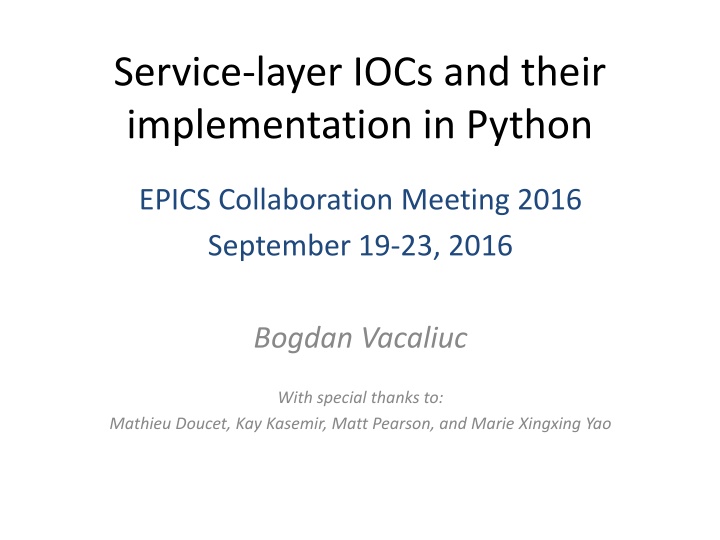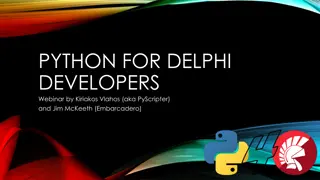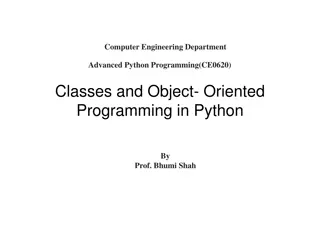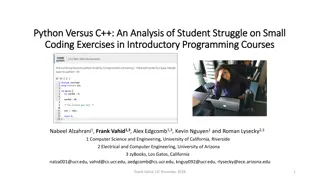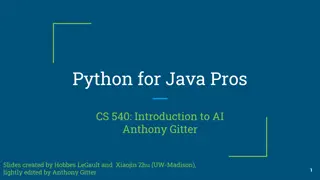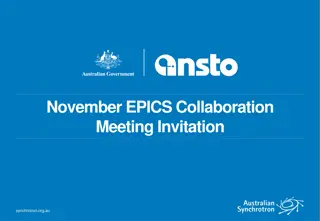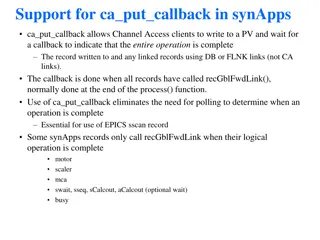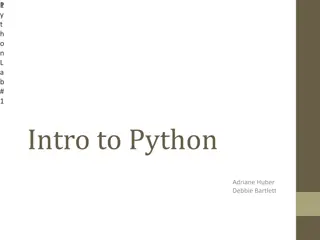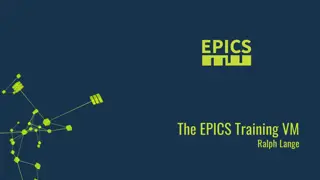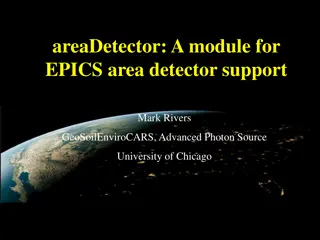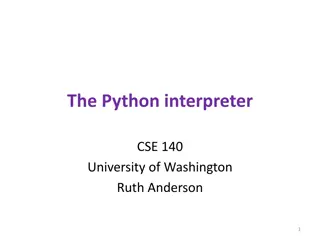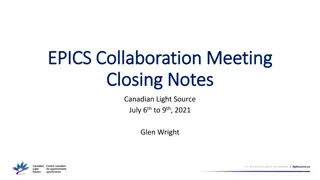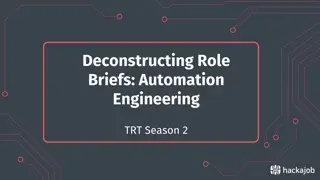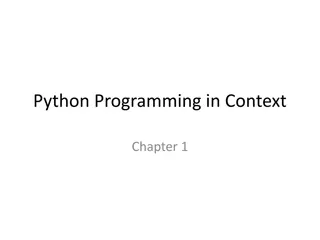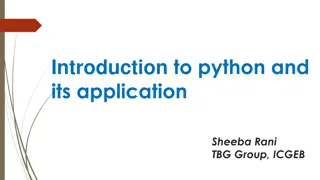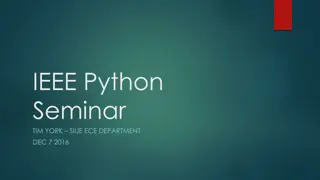Implementing IOC in Python for Enhanced Automation in EPICS Collaboration Meeting
Beamline instrumentation systems require high automation levels, and EPICS is used as a client/server system with extensive server code support for various hardware types. By implementing a service-layer IOC in Python, the server IOC can focus on hardware operation specifics separately from equipment support, enabling easier functionality, manipulation operations, autosave, notification incorporation, and seamless integration with higher-level applications. Utilizing Python allows for complex calculations and fosters easy integration, enhancing automation capabilities in the EPICS environment.
Download Presentation

Please find below an Image/Link to download the presentation.
The content on the website is provided AS IS for your information and personal use only. It may not be sold, licensed, or shared on other websites without obtaining consent from the author.If you encounter any issues during the download, it is possible that the publisher has removed the file from their server.
You are allowed to download the files provided on this website for personal or commercial use, subject to the condition that they are used lawfully. All files are the property of their respective owners.
The content on the website is provided AS IS for your information and personal use only. It may not be sold, licensed, or shared on other websites without obtaining consent from the author.
E N D
Presentation Transcript
Service-layer IOCs and their implementation in Python EPICS Collaboration Meeting 2016 September 19-23, 2016 Bogdan Vacaliuc With special thanks to: Mathieu Doucet, Kay Kasemir, Matt Pearson, and Marie Xingxing Yao
Overview Problem Solution Features Engineering Details Examples Summary
The Problem Beamline instrumentation system needs high levels of automation EPICS is a client/server system Lots of server codes to support many types and models of hardware. Advice: put functionality in the server [1, slide 51] If we need automation, and we heed the advice, we end up with a lot of instrument-specific functionality in the servers... [1] M. Rivers, Using EPICS for Beamline Control and Data Acquisition , Australian Synchroton Beamline Control Workshop, April 2005, available=https://www.synchrotron.org.au/media/tz_portfolio/attachments/52d4c57b9579atz_portfolio_1389675906.ppt
A Solution Service-layer IOCs bump in the wire Are both client and server facing Implemented in Python Enables server IOCs to focus on that which is needed for operation of the hardware Enables instrument-specific behavior and automation to exist separately from equipment support. Use of the Python language is ideal for a high-degree of functionality and capability.
Features String manipulation operations are easy Autosave via an in-house implementation Easily incorporate put-callback notification (Easier to) include non-channel access protocols Easily make complex calculations (numpy, scipy) Foster integration with high level applications codify sequencing needed or enforcing the n+1th PV to initiate an action ... it is important to guarantee that we synchronize acquisition of all these property values with the specified triggering event. [2] [2] J. Hill, R. Lange, Next Generation EPICS Interface to Abstract Data , Publication LA-UR-01-6172, Jan 2001, available=http://www.osti.gov/scitech/biblio/975859
Engineering Details news you can use... Our work is based on pcaspy [3] and PyEpics [4]. All interactions with the IOC occur via PVs All lengthy operations invoked by ::write() spawn a thread that issues a put-callback when complete. Lengthy operations can perform computations, communicate with external systems using CA or non- CA protocols and otherwise use any Python module available in the environment. [3] X. Wang, pcaspy: Portable Channel Access Server in Python , 2011-2016, available=https://pcaspy.readthedocs.io/en/latest/index.html [4] M. Newville, pyepics: EPICS Channel Access for Python , CARS, University of Chicago, 2010-2016, available=http://cars9.uchicago.edu/software/python/pyepics3/index.html
Engineering Details (cont) Subclass from pcaspy.Driver global establish dictionary to describe PVs [3] to be served by this IOC establish autosave establish logging __init__(self): call .setParam() on all PVs defined use Autosave.get() to initialize PVs from autosave store create background thread to update log PV from logging buffer read(self, reason): call .getParam() to return the value of the unprefixed PV, reason write(self, reason, value): call .setParam() to write value of the unprefixed PV, reason call .updatePVs() to update any callbacks if action is lengthy, spawn thread with CAThread() [4] to perform
Implementation Advice use common variables for Log, Status, Simulate provide an engineering UI for each IOC that displays the Log, toggle Simulate, set and observe the served PVs use Status enum variable to track IOC state and encapsulate alarm we chose [ Idle , OK , Working , Error ] Think about the way to invoke a lengthy job [2] we chose to use the n+1th PV idiom it matched well with our Scan Server -based experiment control model
Example: Automated 3-axis Alignment Parametric algorithm [5] Curve fit (numpy) Acceptable fit criteria Enables sample changes and unattended operation [5] B. Vacaliuc, et. al, Experiment Automation with a Robot Arm using the Liquids Reflectometer at the SNS , Proceedings of ICALEPCS2013, San Francisco, CA, USA, 2013, available=http://accelconf.web.cern.ch/AccelConf/ICALEPCS2013/papers/tuppc077.pdf
Example: Nested Scan Generator Queues operations with scan server Sequences several operations including automatic alignment and sample environment ops Reduces likelihood of user entry error
Example: Temperature-Compensated DAQ Monitors experiment progress and adjusts PVs to compensate for beam power variances [6] [6] P. Whitfield, et. al, Extending the Collection and Analysis of Non-Ambient Diffraction Measurements by Time and Temperature-slicing of Event-mode Time-of-flight Neutron Data , Journal of Applied Crystallography, Submitted for publication
Example: Autoreduction Visualization Communicates with restful web service to download reduced data and format into PVs for visualization
Summary Solved the automation of experiments problem in a simple yet highly extensible way Built upon robust and stable implementations Operates at the timescale of human activity Leverages the use of the Python language for rapid development and deployment Measureable gains in Scientific Productivity
Thank You This document has been authored by the Oak Ridge National Laboratory, managed by UT-Battelle LLC under Contract No. DE-AC05-00OR22725 with the U.S. Department of Energy. The U.S. Government retains and the publisher, by accepting the article for publication, acknowledges that the US Government retains a nonexclusive, paid-up, irrevocable, worldwide license to publish or reproduce the published form of this manuscript, or allow others to do so, for US Government purposes.
